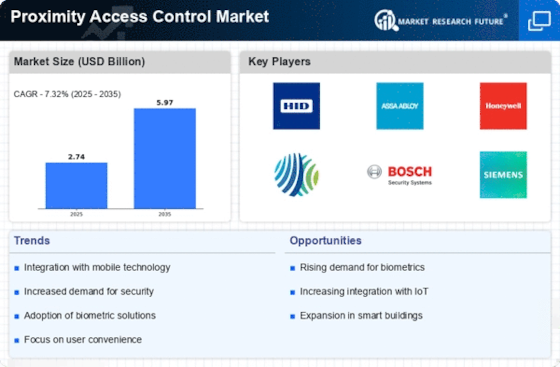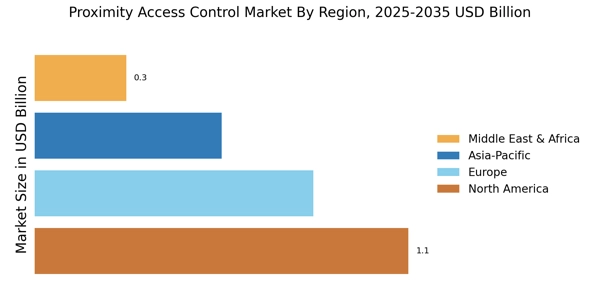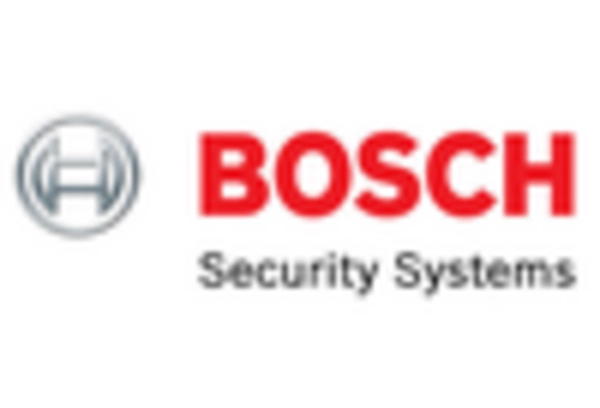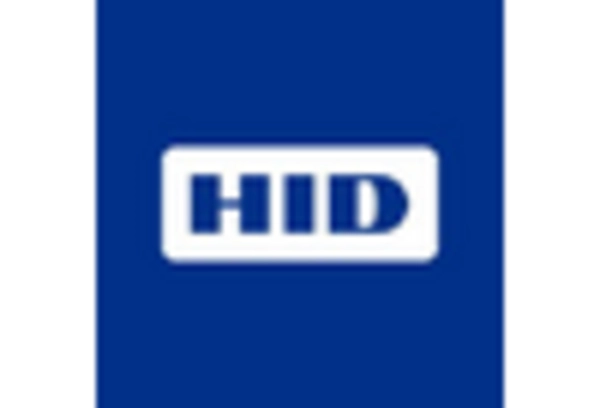Regulatory Compliance
Regulatory compliance is a significant driver for the Proximity Access Control Market, as organizations are mandated to adhere to various security standards and regulations. Compliance with regulations such as GDPR and HIPAA necessitates the implementation of robust access control measures to protect sensitive data. As a result, businesses are increasingly investing in proximity access control systems to ensure they meet these legal requirements. The market is projected to grow as organizations recognize the importance of compliance in avoiding potential fines and reputational damage. Furthermore, the evolving landscape of cybersecurity regulations suggests that the demand for effective access control solutions will continue to rise, positioning proximity access control as a critical component of organizational security strategies.
Growth of Smart Buildings
The growth of smart buildings is significantly influencing the Proximity Access Control Market. As urbanization accelerates, the demand for intelligent infrastructure that integrates various technologies is on the rise. Proximity access control systems are essential components of smart buildings, providing seamless entry solutions while enhancing security. The market for smart building technologies is anticipated to reach USD 100 billion by 2027, indicating a substantial opportunity for proximity access control solutions. These systems not only facilitate efficient access management but also contribute to energy savings and improved user experiences. As more developers and property managers recognize the benefits of integrating proximity access control into their smart building designs, the market is likely to expand further.
Technological Advancements
Technological advancements play a pivotal role in shaping the Proximity Access Control Market. Innovations in hardware and software are driving the development of more sophisticated access control solutions. For instance, the introduction of smart cards and mobile credentials has revolutionized how users interact with access systems. According to recent data, the market for smart card technology is expected to reach USD 15 billion by 2026, indicating a robust growth trajectory. Additionally, the integration of artificial intelligence and machine learning into access control systems enhances their functionality, allowing for real-time monitoring and analytics. This evolution not only improves security but also streamlines operations, making proximity access control systems more appealing to a diverse range of industries.
Increasing Security Concerns
The Proximity Access Control Market is experiencing a surge in demand due to escalating security concerns across various sectors. Organizations are increasingly prioritizing the protection of sensitive information and physical assets. This heightened awareness has led to a projected growth rate of approximately 10% annually in the access control market. As businesses seek to mitigate risks associated with unauthorized access, the adoption of proximity access control systems is becoming more prevalent. These systems offer a seamless and efficient way to manage entry points, thereby enhancing overall security. Furthermore, the integration of advanced technologies, such as biometrics and encryption, is likely to bolster the effectiveness of these systems, making them a preferred choice for organizations aiming to safeguard their premises.
Rising Demand for Contactless Solutions
The rising demand for contactless solutions is a key driver in the Proximity Access Control Market. As consumers and businesses increasingly favor touchless interactions, proximity access control systems that utilize RFID and NFC technologies are gaining traction. This trend is particularly evident in sectors such as retail, healthcare, and transportation, where minimizing physical contact is essential. Market analysis indicates that the contactless access control segment is expected to grow at a CAGR of 12% over the next five years. The convenience and efficiency offered by contactless systems not only enhance user satisfaction but also align with broader health and safety initiatives. Consequently, the adoption of proximity access control systems is likely to accelerate as organizations seek to meet the evolving preferences of their customers and employees.


















Leave a Comment